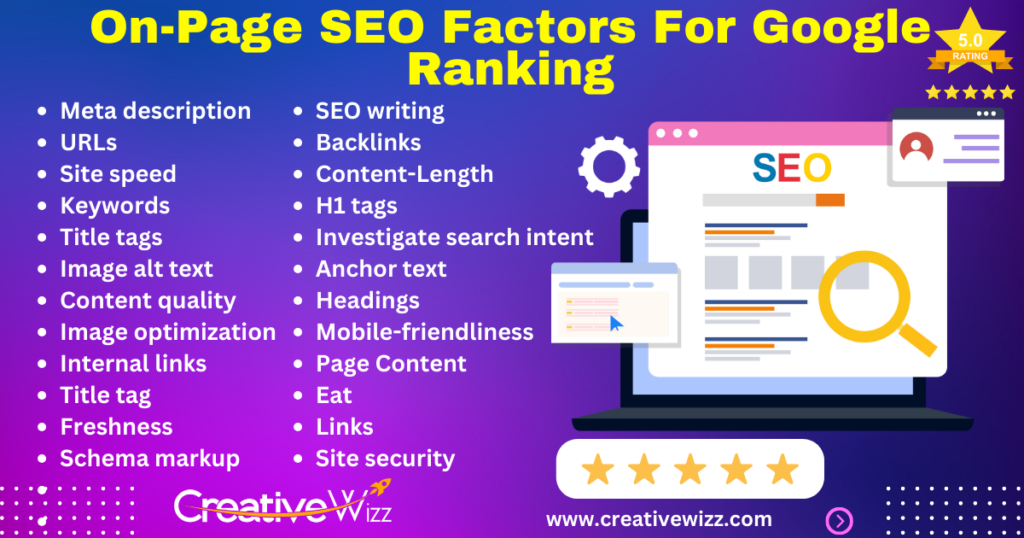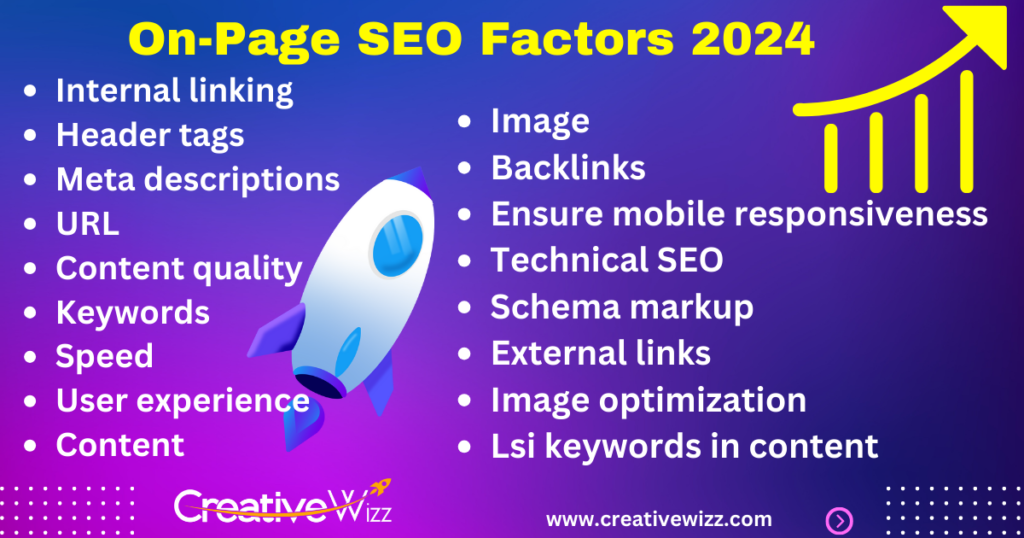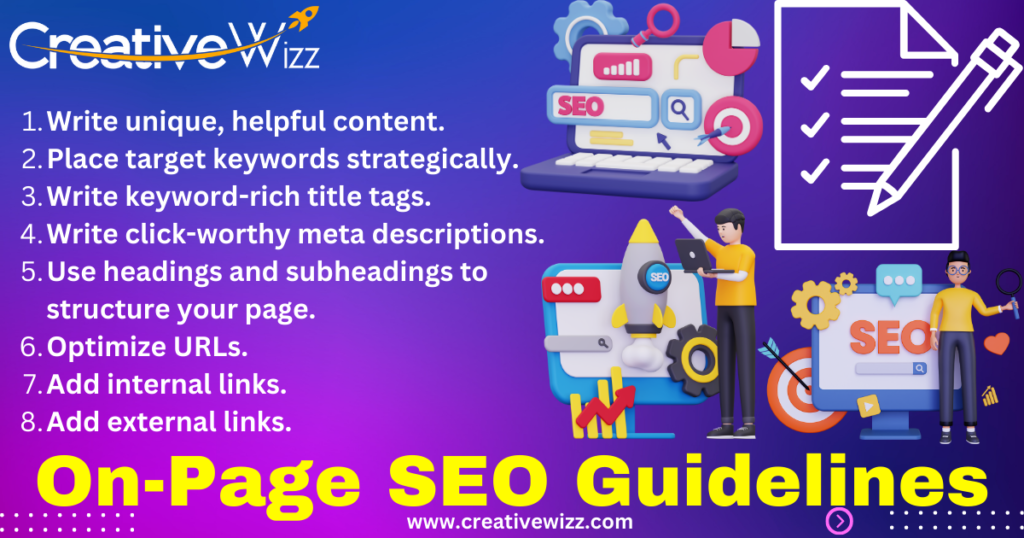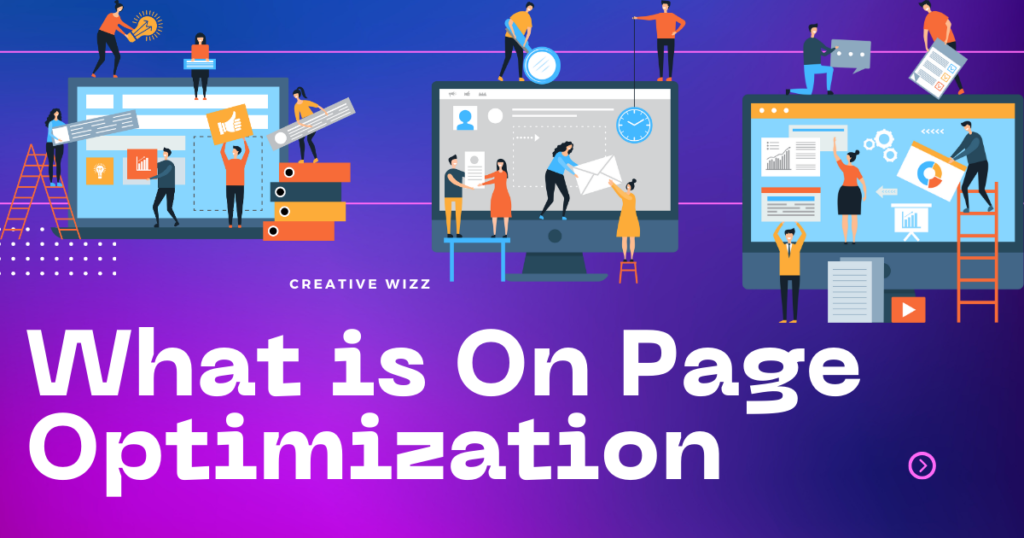In digital marketing, on-page SEO factors are crucial in determining a website’s ranking on search engine results pages (SERPs). This article will delve into the important on-page SEO factors and provide a checklist to help you optimize your website for better visibility and ranking.
What are On-Page SEO Factors?
On-page SEO factors refer to the elements on a website that can be optimized to improve its ranking on search engines. These factors include the content, the HTML source code, and the website architecture. Let’s look at the top 10 on-page SEO factors that you need to consider:
- Keyword Placement: The placement of keywords in your content plays a crucial role in on-page SEO. Including your keywords in the title, headings, and throughout the content is important.
- Meta Tags and Descriptions: Meta tags and descriptions give search engines information about your webpage. They should be descriptive and contain your main keywords.
- URL Structure: URLs should be SEO-friendly, short, and descriptive. Including your main keyword in the URL can improve your on-page SEO.
- Content Quality: High-quality, original content is among the most important on-page SEO factors. It should provide value to your readers and include your keywords naturally.
- Image Optimization: Images should be optimized for speed and include alt text with relevant keywords.
- Internal Linking: Internal links help search engines understand the content and structure of your website, improving its visibility and ranking.
- Mobile Responsiveness: With the increasing use of mobile devices, your website must be mobile-friendly.
- Page Load Speed: A fast-loading website provides a better user experience and is favoured by search engines.
- Schema Markup: Schema markup helps search engines understand your content better, leading to improved SERP rankings.
- Social Sharing Buttons: Including social sharing buttons on your webpage can increase engagement and visibility.
On-Page SEO Factors for Google Ranking

Google uses over 200 factors in their algorithm for ranking websites. However, not all factors are created equal. Here are some on-page SEO Techniques for Google ranking:
- Content Quality: Google favors high-quality, original content that provides value to users.
- Keyword Usage: Using keywords naturally in your content, title, URL, and meta description can improve your Google ranking.
- Page Load Speed: Google considers page load speed as a ranking factor. A fast-loading website provides a better user experience.
- Mobile Responsiveness: With the rise of mobile search, Google favors mobile-friendly websites.
- Secure Website (HTTPS): Google gives a slight ranking boost to secure websites.
30+ On-Page SEO Factors
- URL
- Title
- Internal linking
- Meta description
- Keywords
- Content
- Image optimization
- Site speed
- Alt text
- Mobile-friendliness
- Heading tags
- Images
- Investigate search intent
- Links
- Meta descriptions
- Page speed
- Schema markup
- SEO writing
- Alt tags
- Backlinks
- Content quality
- Identify target keywords
- Keyword placement
- Use subheadings
On-Page SEO Factors 2024

As we look ahead to 2024, it’s clear that the importance of on-page SEO will grow. To stay competitive, businesses must stay updated with the latest on-page SEO factors and techniques. At Creative Wizz, we’re committed to helping our clients navigate the ever-changing landscape of SEO.
The On-Page SEO Alchemy: Transforming Your Website into a Search Engine Magnet
In the bustling marketplace of the digital world, websites are our storefronts, billboards, and battlegrounds for visibility. And just like any good explorer, the savvy business owner understands the importance of a strategic map to conquer this ever-evolving landscape. And that map, my friends, is On-Page SEO.
Think of On-Page SEO as the meticulous alchemy that transforms your website’s raw materials – content, structure, and technical elements – into pure search engine gold. It’s the art of speaking the language that search engines understand, guiding them through your digital haven and showcasing your value to the world.
But mastering this alchemy takes more than a sprinkle of pixie dust. It requires a deeper understanding of the key ingredients, the potent formulas, and the expert techniques that weave your website into the fabric of the internet, making it discoverable, relatable, and, ultimately, irresistible to search engines.
So, grab your mortar and pestle, fellow explorers, and let’s dive into the wondrous world of On-Page SEO:
The Treasure Trove of Important On-Page SEO Factors:
Before we unleash our inner alchemists, let’s map out the terrain. Here are some of the top 10 On-Page SEO factors that hold the key to unlocking Google’s treasure trove:
1. Keyword Alchemy:
They’re the magic spells of the search engine world – Keywords. Your target audience uses these words and phrases to navigate the digital wilderness. Your website needs to speak its language, weaving these keywords seamlessly into your content, titles, and meta descriptions. But remember, it’s not just about keyword stuffing; it’s about strategic integration that provides value and relevance to users and search engines.
2. Content, the King of On-Page SEO:
Forget thin, wispy content that dissipates in the wind. Google craves high-quality, informative content that offers users genuine value. Think of it as a succulent feast you offer to curious explorers. Write engaging articles, captivating blog posts, and informative product descriptions that answer questions, address needs, and keep your audience glued to the screen. Remember, long-form content (think 1,500+ words) is particularly appreciated by search engines, demonstrating your commitment to depth and expertise.
3. Title Tags and Meta Descriptions: Your SEO Signposts:
Think of your title tags and meta descriptions as the enticing banners outside your digital shop. They’re the first things search engines and users see, so make them count! Titles should be concise, relevant, and keyword-rich, accurately reflecting the content. Meta descriptions are your chance to pique curiosity and encourage clicks, offering a compelling snippet of what awaits inside.
4. Headers and Subheadings: Structuring Your Content Landscape:
Keep your visitors from getting lost in a dense jungle of text. Headers and subheadings act as signposts, guiding users through your content and creating a logical flow of information. They also help search engines understand the hierarchy of your content, highlighting key points and making your website easily digestible.
5. Image Optimization: Visual Storytelling for SEO:
A picture is worth a thousand words, but in the SEO world, even those words matter. Optimize your images using descriptive filenames, alt text that accurately describes the image content, and proper compression for faster loading times. Remember, visual storytelling can boost engagement and user experience, sending positive signals to search engines.
6. Internal Linking: Weaving a Web of Discovery:
Your website is an interconnected network, not a collection of isolated islands. Internal linking connects your content logically, allowing users and search engines to navigate seamlessly between pages. This improves user experience and distributes “SEO juice” throughout your website, boosting the visibility of all your pages.
7. User-Friendly Design and Navigation:
Imagine a labyrinthine website with broken buttons and hidden pathways. It’s not exactly the recipe for online success. User-friendly design and intuitive navigation are crucial for both user experience and SEO. Ensure your website is accessible on all devices, with clear menus, responsive layouts, and fast loading times. Remember, a frustrated user is a lost visitor, and search engines also appreciate user-friendly websites.
8. Mobile-First Indexing: Embracing the Pocket-Sized Explorers:
In today’s mobile-first world, ignoring smartphones is like ignoring half the explorers! Ensure your website is mobile-friendly and responsive, adapting seamlessly to any screen size. Google prioritizes mobile-friendly websites in search results, so neglecting this factor is like shutting your doors to half the digital world.
The On-Page SEO Alchemy (Cont.): Mastering the Formulas for Ranking Success

We’ve explored the treasure trove of essential On-Page SEO factors, but the journey continues. Like any skilled alchemist, mastering this art requires understanding the potent formulas that transform these ingredients into powerful ranking potions:
1. Keyword Research: Unearthing the Golden Nuggets:
Keyword research is your treasure map, guiding you to the hidden gold of relevant keywords with high search volume and low competition. Tools like Google Keyword Planner and SEMrush can help you unearth these gems, allowing you to tailor your content and optimize your website for maximum visibility. Remember, targeting a mix of broad keywords for general search intent and long-tail keywords for specific user queries can broaden your reach and attract qualified leads.
2. Semantic Search: Bridging the Meaning Gap:
Search engines aren’t just looking for keyword matches; they’re trying to understand the meaning and intent behind your content. This is where semantic search comes in. Focus on creating semantically rich content, using related keywords, synonyms, and natural language phrases that reflect the true context of your page. Think of it as speaking not just the language of keywords but the language of user intent.
3. Content Marketing: The Alchemy of Storytelling:
High-quality content is about more than just informative articles and product descriptions. It’s about storytelling. Inject personality, humor, and emotion into your content, making it relatable and engaging. Utilize diverse formats like videos, infographics, and podcasts to cater to different learning styles and preferences. Remember, consistent content creation demonstrates expertise and keeps your audience returning for more, sending positive signals to search engines.
4. Technical SEO: The Hidden Gears of the Machine:
On-page SEO isn’t just about surface-level elements. The invisible gears of technical SEO play a crucial role in your ranking success. Ensure your website has a clean and efficient code structure, fast loading times, and mobile-friendliness. Utilize tools like Google Search Console and Screaming Frog to identify and fix technical issues hindering your visibility. Remember, a technically sound website is a happy website, both for users and search engines.
5. Site Structure and Navigation: Charting the Path to Discovery:
Think of your website’s structure as a well-organized map. Users and search engines need to navigate your content with ease. Implement a logical hierarchy of pages, categorize content accurately, and use internal linking strategically to connect related pages. Remember, a clear and consistent website structure enhances user experience and helps search engines crawl and index your content efficiently.
6. Local SEO: Claiming Your Territory in the Digital Jungle:
Local SEO is like planting your flag on the digital map if your business has a physical location. Optimize your website with your NAP (Name, address, and phone number) information, claim your Google My Business listing, and encourage positive online reviews. This will help you rank higher in local search results, attracting customers in your vicinity.
7. Schema Markup: Speaking the Language of Search Engines:
Think of schema markup as adding helpful annotations to your content, providing search engines with richer information about your pages. This includes product ratings, event dates, or recipe ingredients. Implementing schema markup helps search engines understand your content better and can lead to richer search results, like star ratings in the SERPs.
8. User Engagement: The Elixir of Ranking Success:
On-page SEO isn’t just about optimizing for search engines; it’s about optimizing for your users. Encourage audience engagement through interactive quizzes, polls, and comment sections. Make it easy for users to share your content on social media. Monitor user behaviour and engagement metrics to understand what resonates with your audience and refine your content strategy accordingly. Remember, happy users mean a happy website, which translates to positive signals for search engines.
9. Link Building: Forging Alliances in the Digital World:
Think of link building as weaving valuable connections in the digital world. Earning backlinks from high-authority websites tells search engines that your content is trustworthy and informative. Focus on creating valuable content that others naturally want to link to. Collaborate with other websites in your niche, participate in online communities, and contribute guest posts to relevant blogs. Remember, quality over quantity is key – focus on building strategic relationships that add value to your audience and improve your website’s authority.
10. Continuous Optimization: The Never-Ending Quest for Gold:
SEO is constantly evolving, so your On-Page alchemy should be ongoing. Monitor your website’s performance using tools like Google Analytics and SEO platforms. Stay updated on the latest SEO trends and algorithm changes. Regularly analyze your content, keywords, and technical aspects to identify areas for your website.
The On-Page SEO Alchemy (Cont.): The Tools and Techniques for Masterful Optimization
Now that we’ve explored the key ingredients and potent formulas of On-Page SEO let’s delve into the crucial tools and techniques that equip you to become a master alchemist of your website’s visibility:
Tools for Treasure Hunting:
- Keyword Research Tools: Google Keyword Planner, SEMrush, Ahrefs: These tools help you unearth valuable keywords with high search volume and low competition, guiding your content creation and optimization strategies.
- SEO Analysis Platforms: Moz, Ahrefs, Ubersuggest: These platforms analyze your website’s technical health, backlink profile, and keyword rankings, highlighting areas for improvement and providing actionable insights.
- Content Optimization Tools: Yoast SEO, SEMrush Content Scorecard: These tools offer real-time suggestions for keyword integration, readability, and overall content optimization, ensuring your content aligns with SEO best practices.
- Rank Tracking Tools: SEMrush, Moz Pro, Ahrefs: These tools track your website’s ranking for specific keywords over time, allowing you to measure the effectiveness of your SEO efforts and identify areas for further optimization.
Techniques for Crafting SEO Gold:
- Content Calendar and Planning: Plan your content creation around relevant keywords and user intent, ensuring consistent fresh content that keeps your audience engaged and search engines satisfied.
- On-Page Optimization Checklist: Develop a checklist that ensures you’re optimizing all essential elements of each page, from title tags and meta descriptions to internal linking and image optimization.
- Data-Driven Decision Making: Analyze your website data and SEO metrics to understand what’s working and needs improvement. Refrain from relying on guesswork; base your optimization decisions on concrete data insights.
- Experimentation and Adaptation: SEO is an ever-evolving landscape. Experiment with different content formats, keywords, and optimization techniques to see what resonates with your audience and drives results.
The Creative Wizz Advantage:
At Creative Wizz, we understand that On-Page SEO is an intricate art form, not a one-size-fits-all formula. We’re your team of seasoned SEO alchemists equipped with the expertise, tools, and passion to transform your website into a search engine magnet. Here’s what sets us apart:
- Personalized SEO Strategies: We craft custom SEO plans tailored to your unique business goals, target audience, and industry.
- Data-Driven Approach: We leverage data analytics and SEO tools to make informed decisions, ensuring your strategy is based on concrete insights, not guesswork.
- Content Creation Expertise: Our team of skilled writers and strategists create high-quality, engaging content that resonates with your audience and boosts your search engine ranking.
- Technical SEO Optimization: We ensure your website’s technical foundation is rock-solid, with fast loading times, mobile-friendliness, and code clean-up for optimal search engine crawling and indexing.
- Continuous Monitoring and Reporting: We regularly track your SEO performance metrics, providing transparent reports and ongoing updates on your progress.
The Most Important On-Page SEO Factors for 2024
On-page optimization is a crucial part of any SEO strategy. By improving key on-page elements, you can send clear signals to search engines about the relevance of your pages for certain keywords. This, in turn, can boost your Google rankings and organic traffic over time.
This comprehensive guide will cover the most important on-page SEO factors you need to focus on in 2024 for top search engine rankings. Whether you run a blog, business website, or ecommerce store, optimizing these on-page elements is essential for SEO success.
Let’s dive into the top on-page SEO factors to improve your Google rankings this year!
- Optimize Page Titles
The title tag tells search engines and visitors what a specific page is about. Page titles should:
- Be descriptive and keyword-focused – Include your target keyword early in the title.
- Concise – Keep titles under 60 characters.
- Unique – Every page should have a different title.
- Appealing – Titles attract searchers to click and visit your page.
Proper page title structure:
Target Keyword – Topic | Website Name
Example
On-Page SEO Factors – SEO Guide for 2024 | Creative Wizz
Page titles directly impact click-through rates from search results and relevancy for keywords. This makes them one of the most important on-page SEO elements.
- Meta Descriptions
The meta description provides a short paragraph summary of a webpage in search engine results. Optimized meta descriptions improve click-through rates.
Effective meta descriptions:
- Concise at 155-160 characters
- Appealing and human-friendly
- Include target keywords naturally
- Create curiosity to go through
For example:
Learn the essential on-page SEO factors like title tags, headings, and page speed to optimize your website for higher Google rankings in 2024.
Meta descriptions don’t directly influence rankings. However, compelling descriptions attract more visitors from SERPs.
- Header Tags (H1, H2, H3)
Header tags (H1, H2, H3) break text content into logical sections. They establish a hierarchy and improve on-page SEO.
- H1 tags should reflect the main topic and contain target keywords.
- H2 subheadings into detail.
- Lower H tags (H3, H4) provide deeper levels of detail.
Use keywords naturally in headings without over-optimizing. Header tags boost page relevance in search.
- Image Optimization
Optimizing images with keywords improves on-page SEO. For each image, provide:
- Descriptive file name – “on-page-seo-factors.jpg”
- ALT text – Concise description with keyword
- Title attribute – Same text as alt attribute
This gives search bots more signals about the image content. Plus, optimized filenames directly impact image SERP rankings.
Compress images for faster page loading. Use relevant, high-quality images that enhance the visitor experience.
- outbound, internal Links
Internal links point visitors to related content on your site. Anchor text provides link context for users and search bots.
Best practices for internal linking:
- Use descriptive, keyword-focused anchor text – Helps pages rank for those terms.
- Link to high-quality, relevant internal content – Improves visitor experience.
- Vary anchor text – Don’t over-optimize with the same anchor text.
- Naturally embed links in content – Don’t just list links.
Internal links influence relevance and search rankings for linked pages. Link intentionally to enhance on-site navigation and SEO.
- URL Structure
Google considers web page URLs to be a minor ranking factor. Optimized, clean, short URLs are best for on-page SEO.
- Use target keywords in slugs – “example.com/on-page-seo/”
- Avoid overstuffing URLs with keywords
- Short, clean and easy to understand
- Separate words with hyphens vs underscores
- Static vs dynamic URLs – “example.com/blog/post-title/”
Optimized URLs improve click-throughs and indicate relevancy.
- Page Speed Optimization
Page speed impacts user experience, bounce rate, and search rankings. Optimizing page speed is crucial for on-page SEO.
Test your website’s speed and optimize:
- Enable caching and compression
- Minify code
- Optimize images
- Limit redirects
- Minimize plugins/bloat
- Upgrade web hosting for faster server response times
Faster page loads equal higher conversions and better SEO.
- Mobile Optimization
With Google’s mobile-first indexing, having a fast, mobile-friendly site is vital. Ensure your website is responsive or has a dedicated mobile version.
Mobile optimization tips:
- Simplified menus/navigation
- Clickable elements like buttons
- One column layout
- Minimal scrolling
- Legible font sizes
- Accelerated Mobile Pages (AMP)
Having an optimized mobile experience improves SEO and usability for on-the-go users.
- Schema Markup
Schema markup uses code to label different types of data on a webpage. This helps search bots better understand the content.
Implement schema markup for:
- Blog posts
- Job listings
- Local business info
- Reviews
- Site navigation
- Videos
- And more.
JSON-LD and Microdata are the most common schema formats. Schema helps pages rank better for featured snippets and rich results.
- Quality Content
At the foundation of good on-page SEO is creating compelling, useful content that engages visitors. Optimize content with keywords, links, media, and formatting like headings that make it easy to digest.
Focus your content on providing value to readers rather than over-optimizing just for search engines. High-quality content that attracts and converts visitors has the biggest impact on organic growth.
Bonus: Technical On-Page SEO Factors
Here are some additional technical elements that impact on-page SEO:
- Structured data – Like schema, it helps search engines understand your content better.
- Clean site architecture – Simple IA and navigation help bots crawl efficiently.
- Valid HTML – No broken links or malformed code.
- Text to HTML ratio – Higher text content is better.
- Site security – HTTPS, SSL certificates, eliminate vulnerabilities.
While not directly optimization techniques, getting these technical SEO factors right improves how search engines crawl, index, and rank your pages.
Key Takeaways for On-Page SEO Success
Optimizing these essential on-page factors helps your website rank better organically:
- Descriptive, keyword page titles and metadata
- Proper heading tag structure
- Optimized image file names and alt text
- Internal linking between relevant pages
- Short, clean URLs with target keywords
- Fast page load speeds for all visitors
- Mobile-friendly, responsive website
- Structured data markup for rich results
- High-quality, informative content
By focusing on these areas of on-page SEO, you can significantly improve your Google rankings and organic traffic for 2024 and beyond. Let me know if you have any other on-page optimization questions!
On-Page SEO Factors List:
Content:
- Keyword Optimization: Integrating relevant keywords into your content, titles, meta descriptions, and headers naturally and strategically.
- Content Quality: Creating high-quality, informative, and engaging content that resonates with your target audience and answers their search queries.
- Content-Length: Focusing on long-form content (1500+ words) for more in-depth coverage and user satisfaction.
- Internal Linking: Connecting your pages logically through internal links to improve user navigation and distribute SEO value.
- Freshness and Updates: Regularly updating your content with new information and insights to keep it relevant and engaging.
Technical SEO:
- Website Speed: Ensuring your website loads quickly and efficiently to avoid frustrating users and hindering search engine ranking.
- Mobile-friendliness: Make sure your website adapts seamlessly to all devices, especially mobile, as Google prioritizes mobile-friendly websites.
- Structured Data: Utilizing schema markup to provide detailed information about your content to search engines, potentially leading to richer search results.
- Code Cleanliness: Maintaining a clean and efficient website code structure for optimal crawling and indexing by search engines.
- Image Optimization: Using descriptive filenames, alt text, and proper compression for faster loading and accessibility of images.
User Experience:
- Navigation and Design: Providing clear and intuitive website navigation visually appealing design and a user-friendly interface.
- Accessibility: Ensuring your website is accessible to everyone, including people with disabilities, through features like alt text and descriptive page titles.
- Engagement: Incorporating interactive elements like quizzes, polls, and comments sections to encourage user engagement and keep them coming back.
- Page Structure: Structuring your content with clear headings, subheadings, bullet points, and images to enhance readability and user experience.
- Mobile Usability: Providing a seamless and enjoyable user experience on mobile devices with responsive design and intuitive touch controls.
Additional Factors:
- URL Structure: Using clear and concise URLs that accurately reflect the content of your page.
- Social Signals: Encouraging social sharing of your content to build buzz and backlinks.
- Local SEO (if applicable): Optimizing your website for local search if you have a brick-and-mortar location.
Remember, On-Page SEO is a journey, not a destination. You can transform your website into a beacon of visibility in the digital jungle with the right ingredients, formulas, and tools. At Creative Wizz, we’re your trusted guides, ready to equip you with the knowledge and expertise to master this alchemy and conquer the ever-evolving landscape of search engine optimization.
Conclusion
In conclusion, on-page SEO is a critical component of any SEO strategy. Understanding and implementing these on-page SEO factors can improve your website’s visibility and ranking on search engines. Remember, SEO is a long-term strategy requiring consistency and patience. But with the right approach and the help of Creative Wizz, you can achieve your SEO goals.
On-Page SEO FAQs
1. What are the most important On-Page SEO factors?
The top contenders in the On-Page SEO arena include:
- Keyword Alchemy: Mastering relevant keywords and weaving them Natur
- Ally into your content, titles, and meta descriptions.
- Content, the King: Creating high-quality, informative content that answers user questions and keeps them engaged.
- Title Tags and Meta Descriptions: Your captivating banners concisely reflect your content and attract clicks.
- Headers and Subheadings: Clear signposts guiding users through your content and ensuring smooth navigation.
- Image Optimization: Visual storytelling with descriptive filenames, alt text, and proper compression.
- Internal Linking: Weaving a web of discovery, connecting related pages and distributing SEO juice throughout your website.
2. How often should I update my content for SEO?
Freshness matters! Regularly updating your content with new information, insights, and trends keeps your audience engaged and signals relevance to search engines. Aim for consistent content creation, targeting at least weekly updates for high-traffic pages and monthly refreshes for less frequent ones. Remember, quality always trumps quantity, so focus on creating valuable content that truly benefits your audience.
3. What’s the difference between On-Page and Off-Page SEO?
On-page SEO focuses on optimizing the elements within your website, like content, structure, and technical aspects. On the other hand, Off-Page SEO deals with factors outside your website, primarily building backlinks from high-authority websites and boosting your online reputation. Think of it as On-Page SEO polishing your website’s internal armour. At the same time, Off-Page SEO builds your external brand authority. Both are crucial for conquering the search engine wilderness!
4. Should I use a lot of keywords in my content?
Keyword stuffing is a big no-no! While incorporating relevant keywords is essential, prioritize natural language and user experience. Think of keywords as spices adding flavour, not the whole dish. Focus on creating informative and engaging content that organically includes relevant keywords; search engines will appreciate your authenticity.
5. How can I track my On-Page SEO performance?
Tools like Google Search Console, Google Analytics, and SEO platforms like SEMrush and Ahrefs are your friends. These tools provide valuable insights into your website’s ranking, traffic, and technical health. Monitor your keyword rankings, analyze user engagement metrics, and identify areas for improvement based on data-driven insights. Remember, tracking your performance is essential for making informed optimization decisions and ensuring your SEO alchemy bears fruit.
6. Can I do On-Page SEO, or need a professional?
While basic On-Page SEO techniques can be tackled independently, mastering the intricate formulas and staying ahead of algorithm changes may require expert guidance. At Creative Wizz, we’re seasoned SEO alchemists with the tools, knowledge, and experience to elevate your website’s visibility to new heights. Contact us today and let us help you unlock the true potential of On-Page SEO!
7. What are the on-page factors for SEO?
On-page SEO factors are the internal elements of your website that you can optimize to improve search engine visibility. They’re like the ingredients you use to brew a potent SEO potion, attracting traffic and ranking higher in search results. These factors include:
- Keyword Alchemy: Weave relevant keywords into your content, titles, and meta descriptions naturally and strategically.
- Content, the King: Creating high-quality, informative, and engaging content that resonates with your audience and satisfies their search intent.
- Title Tags and Meta Descriptions: Crafting concise and compelling titles and meta descriptions that accurately reflect your page content and entice clicks.
- Headers and Subheadings: Structuring your content with clear headings and subheadings to enhance readability and guide users through your information.
- Image Optimization: Optimizing images with descriptive filenames, alt text, and proper compression for faster loading and improved accessibility.
- Internal Linking: Building a web of connections between your pages through strategic internal linking to improve user navigation and distribute SEO value.
- User-Friendly Design and Navigation: Ensuring your website is visually appealing, easy to navigate, and accessible on all devices.
- Mobile-First Indexing: Make sure your website adapts seamlessly to mobile devices, as Google prioritizes mobile-friendly websites in search results.
8. What is on-page, and what are its factors?
“On-page” refers to everything within your website that you can directly control and optimize for search engines. Think of it like organizing your house to make it welcoming and accessible to guests. The “factors” are the specific elements you work on to optimize, like polishing the furniture, arranging the rooms logically, and placing inviting signage. Just like a well-organized house attracts visitors, a well-optimized website attracts search engines and users alike.
9. What does SEO include on-page?
On-page SEO encompasses all the internal optimizations you can make to your website, from the content you create to the technical aspects of its structure and code. It’s like painting a beautiful picture on a sturdy canvas. The content is the vibrant artwork, while the technical aspects are the strong frame ensuring the masterpiece remains visible and accessible.
10. Which of the following is an aspect of on-page SEO?
(Please provide a multiple-choice question for me to answer accurately.)
11. What are SEO factors on-page & off-page?
On-page and off-page are two pillars of SEO, working together to boost your website’s visibility. Imagine them as your website’s wings:
- On-page SEO: These are the internal factors you directly control, like the quality of your content, technical aspects, and user experience. They’re like building strong wing muscles.
- Off-page SEO: These are external factors like backlinks from high-authority websites and positive online reputation. They’re like catching favourable wind currents to propel your website further.
Both types of factors are crucial for success. Strong on-page SEO ensures your website is worthy of flight, while off-page SEO helps you soar in the vast digital sky.
12. What are the three primary components of on-page optimization?
The three core components of on-page optimization are:
- Content: This is the heart of your website, engaging users with valuable information and answering their search queries. Think of it as the fuel that keeps your SEO engine running.
- Technical SEO: This ensures your website is technically sound, with fast loading times, mobile-friendliness, and a clean code structure. It’s like ensuring your plane’s engine is well-oiled and functioning smoothly.
- User Experience: This focuses on making your website easy to navigate, visually appealing, and enjoyable. It’s like designing a comfortable and intuitive cockpit for your users to navigate the digital skies easily.














